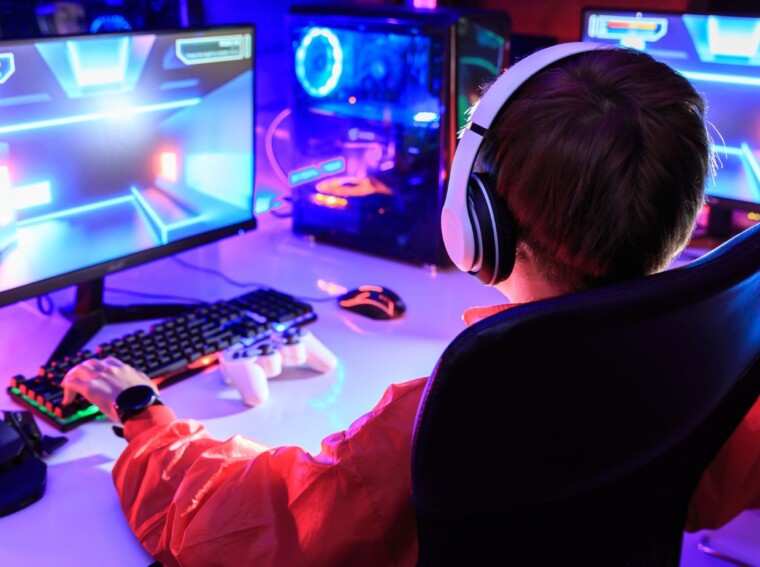Looking to learn how to move your mouse to a second monitor while in the middle of a game? Don’t worry, I’ve got you covered! Many gamers nowadays prefer using multiple monitors for an enhanced gaming experience. However, navigating between screens can sometimes be a bit tricky. In this article, I’ll explain step-by-step how you can seamlessly move your mouse to a second monitor while enjoying your favorite game.
Firstly, it’s important to ensure that your computer recognizes both monitors. To do this, right-click on your desktop and select “Display Settings” from the drop-down menu. Here, you’ll see a representation of both monitors. If the second monitor is not detected, click on “Detect” and Windows will search for it.
Once both monitors are recognized, go ahead and launch your game. Most modern games automatically lock the mouse cursor within their windowed mode or fullscreen mode by default. To unlock it and freely move between screens, press the Alt+Tab keys simultaneously on your keyboard.
Now that you have regained control over your cursor, simply move it towards the edge of your primary monitor until it seamlessly transitions onto the second screen. You should now be able to interact with applications or perform tasks on the second monitor while keeping your game running smoothly on the primary one.
How To Move Mouse To Second Monitor While In Game
When it comes to playing games on multiple monitors, one common challenge is figuring out how to move your mouse seamlessly between screens while immersed in the game. Fortunately, there are some simple steps you can follow to configure your multiple monitors within the game settings and make this process much smoother.
Here’s a guide on how to configure multiple monitors in the game settings:
- Access the game settings: Start by launching the game and navigating to the options or settings menu. Look for a section specifically related to display or graphics settings.
- Enable multi-monitor support: In the display or graphics settings, locate the option that enables multi-monitor support. This setting may have different names depending on the game, such as “extended display” or “multi-display mode.” Toggle this option ON to activate multi-monitor functionality.
- Adjust monitor arrangement: Once multi-monitor support is enabled, you’ll likely see a diagram representing your connected monitors. Take note of their positions and adjust their arrangement accordingly within the software interface. This step ensures that your mouse movement aligns with your physical monitor setup.
- Customize cursor behavior: Some games offer additional customization options for mouse behavior across multiple monitors. Look for settings related to cursor confinement or boundary crossing. Enabling these features helps prevent accidental mouse movements outside of the active window while playing.
- Test and refine: After configuring your desired monitor arrangement and cursor behavior, it’s essential to test everything out within a gameplay session. Pay attention to any issues you encounter—such as delayed cursor movement or misalignment—and revisit the previous steps if needed until you achieve optimal performance.
Keep in mind that not all games have built-in support for multi-monitor setups, so it’s essential to check each individual game’s compatibility beforehand. Additionally, system requirements and hardware capabilities can also impact the performance of multi-monitor gaming, so ensure your computer meets the necessary specifications for a seamless experience.

Optimizing Performance On Dual Monitors
When it comes to gaming on dual monitors, optimizing performance is crucial to ensure a smooth and enjoyable experience. While the focus of this article is how to move your mouse to the second monitor while in-game, it’s important to consider some key factors that can enhance overall performance on dual monitors. Here are a few tips and techniques to maximize your gaming setup:
- Graphics Settings: Adjusting the graphics settings in your game can have a significant impact on performance when using dual monitors. Lowering graphics quality or reducing certain effects can help alleviate strain on your system and allow for better frame rates.
- GPU Power: Double-check that your graphics card has enough power to handle running games smoothly across both monitors. Upgrading to a more powerful GPU may be necessary if you’re experiencing lag or stuttering during gameplay.
- Monitor Placement: Properly positioning your monitors can also play a role in optimizing performance.
- Display Settings: Adjusting display settings within Windows can help fine-tune your setup for gaming across multiple monitors..
- Task Management: Close unnecessary background applications and processes before launching a game on dual monitors. This helps free up system resources and reduces potential bottlenecks that could affect performance.
Remember, every system is unique, so it may require some trial and error to find the optimal settings for your specific hardware configuration. Experiment with different options until you achieve the desired results, keeping in mind that finding the right balance between visual quality and smooth gameplay is key.

